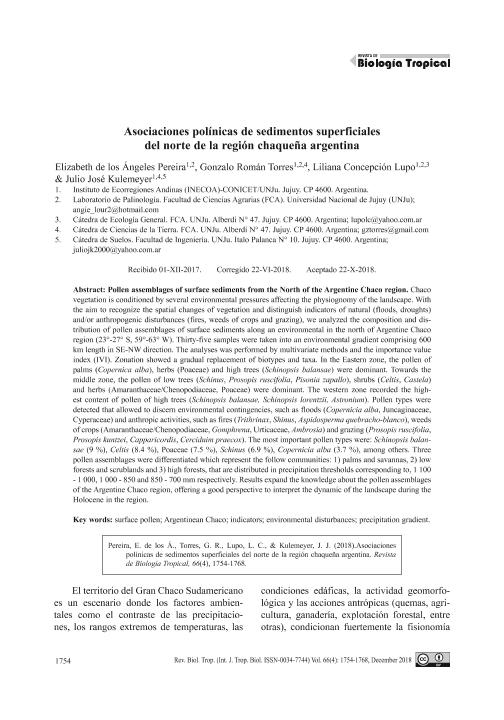Artículo
La vegetación chaqueña esta condicionada por diversas presiones ambientales que afectan la fisionomía del paisaje. Con el objetivo de reconocer cambios espaciales de la vegetación y distinguir indicadores de disturbios naturales (inundaciones, sequías) y/o antrópicos (incendios, malezas de cultivos y pastoreo), se analizó la composición y distribución de las asociaciones polínicas de sedimentos superficiales sobre un gradiente ambiental al norte de la región chaqueña argentina (23°-27° S & 59°- 63° W). Se tomaron 35 muestras en un gradiente de 600 km en dirección SE-NO. El análisis se realizó con métodos multivariados y el índice de valor de importancia (IVI). La zonación mostró un reemplazo gradual de biotipos y taxones. En la zona oriental dominó el polen de palmeras (Copernica alba), hierbas (Poaceae) y árboles altos (Schinopsis balansae). Hacia la zona central predominó el polen de árboles bajos (Schinus, Prosopis ruscifolia, Pisonia zapallo), arbustos (Celtis, Castela) y hierbas (Amaranthaceae/Chenopodiaceae, Poaceae). La zona occidental presentó altos contenidos de polen de árboles altos (Schinopsis balansae, Schinopsis lorentzii, Astronium). Se detectaron conjuntos polínicos que permitieron discernir contingencias ambientales, como las inundaciones (Copernicia alba, Juncaginaceae, Cyperaceae) y actividades antrópicas, tales como incendios (Trithrinax, Shinus, Aspidosperma quebracho-blanco), malezas de cultivos (Amaranthaceae/ Chenopodiaceae, Gomphrena, Urticaceae, Ambrosia) y pastoreo (Prosopis ruscifolia, Prosopis kuntzei, Capparicordis, Cerciduim praecox). Los tipos polínicos más importantes fueron: Schinopsis balansae (9 %), Celtis (8.4 %), Poaceae (7.5 %), Schinus (6.9 %), Copernicia alba (3.7 %), entre otros. Se diferenciaron tres asociaciones polínicas que representaron las comunidades de: 1) palmares y sabanas, 2) bosques bajos y matorrales y 3) bosques altos, que se distribuyeron en umbrales de precipitación de 1 100 - 1 000, 1 000 -850 y 850 - 700 mm respectivamente. Los resultados amplían el conocimiento sobre las asociaciones polínicas de la región chaqueña argentina, ofreciendo una buena perspectiva para interpretar la dinámica del paisaje durante el Holoceno en la región. Chaco vegetation is conditioned by several environmental pressures affecting the physiognomy of the landscape. With the aim to recognize the spatial changes of vegetation and distinguish indicators of natural (floods, droughts) and/or anthropogenic disturbances (fires, weeds of crops and grazing), we analyzed the composition and distribution of pollen assemblages of surface sediments along an environmental in the north of Argentine Chaco region (23°-27° S, 59°-63° W). Thirty-five samples were taken into an environmental gradient comprising 600 km length in SE-NW direction. The analyses was performed by multivariate methods and the importance value index (IVI). Zonation showed a gradual replacement of biotypes and taxa. In the Eastern zone, the pollen of palms (Copernica alba), herbs (Poaceae) and high trees (Schinopsis balansae) were dominant. Towards the middle zone, the pollen of low trees (Schinus, Prosopis ruscifolia, Pisonia zapallo), shrubs (Celtis, Castela) and herbs (Amaranthaceae/Chenopodiaceae, Poaceae) were dominant. The western zone recorded the highest content of pollen of high trees (Schinopsis balansae, Schinopsis lorentzii, Astronium). Pollen types were detected that allowed to discern environmental contingencies, such as floods (Copernicia alba, Juncaginaceae, Cyperaceae) and anthropic activities, such as fires (Trithrinax, Shinus, Aspidosperma quebracho-blanco), weeds of crops (Amaranthaceae/Chenopodiaceae, Gomphrena, Urticaceae, Ambrosia) and grazing (Prosopis ruscifolia, Prosopis kuntzei, Capparicordis, Cerciduim praecox). The most important pollen types were: Schinopsis balansae (9 %), Celtis (8.4 %), Poaceae (7.5 %), Schinus (6.9 %), Copernicia alba (3.7 %), among others. Three pollen assemblages were differentiated which represent the follow communities: 1) palms and savannas, 2) low forests and scrublands and 3) high forests, that are distributed in precipitation thresholds corresponding to, 1 100 - 1 000, 1 000 - 850 and 850 - 700 mm respectively. Results expand the knowledge about the pollen assemblages of the Argentine Chaco region, offering a good perspective to interpret the dynamic of the landscape during the Holocene in the region.
Asociaciones polínicas de sedimentos superficiales del norte del chaco argentino
Título:
Pollen assemblages of surface sediments from the North of the Argentine Chaco region
Pereira, Elizabeth de Los Angeles ; Torres, Gonzalo Román
; Torres, Gonzalo Román ; Lupo, Liliana Concepcion
; Lupo, Liliana Concepcion ; Kulemeyer, Julio José
; Kulemeyer, Julio José
 ; Torres, Gonzalo Román
; Torres, Gonzalo Román ; Lupo, Liliana Concepcion
; Lupo, Liliana Concepcion ; Kulemeyer, Julio José
; Kulemeyer, Julio José
Fecha de publicación:
10/2018
Editorial:
Universidad de Costa Rica
Revista:
Revista de Biología Tropical
ISSN:
0034-7744
Idioma:
Español
Tipo de recurso:
Artículo publicado
Clasificación temática:
Resumen
Archivos asociados
Licencia
Identificadores
Colecciones
Articulos(INECOA)
Articulos de INSTITUTO DE ECORREGIONES ANDINAS
Articulos de INSTITUTO DE ECORREGIONES ANDINAS
Citación
Pereira, Elizabeth de Los Angeles; Torres, Gonzalo Román; Lupo, Liliana Concepcion; Kulemeyer, Julio José; Asociaciones polínicas de sedimentos superficiales del norte del chaco argentino; Universidad de Costa Rica; Revista de Biología Tropical; 66; 4; 10-2018; 1754-1768
Compartir
Altmétricas



